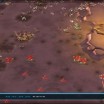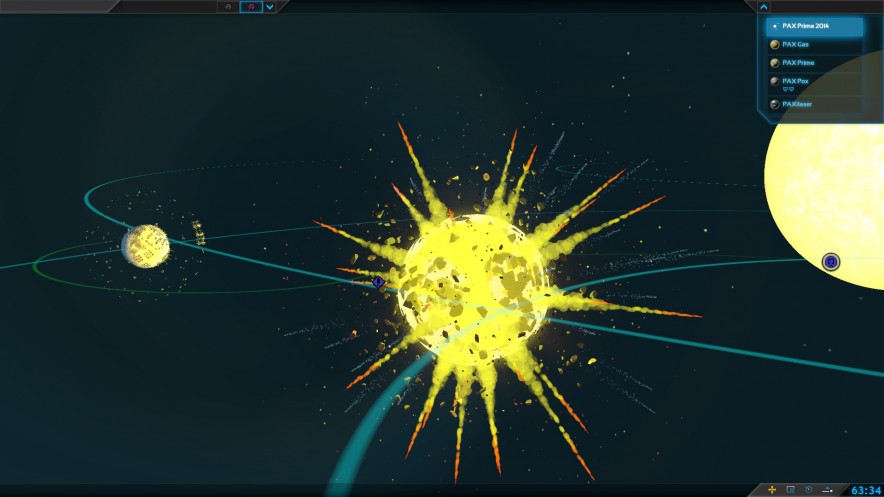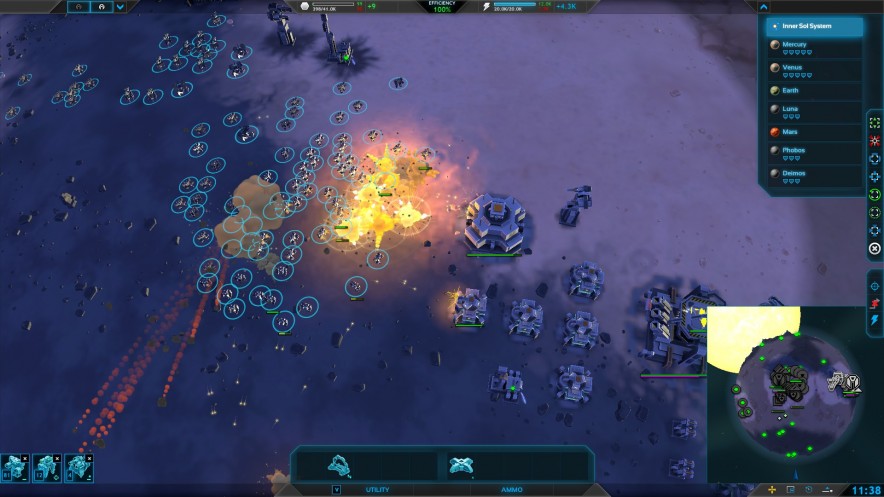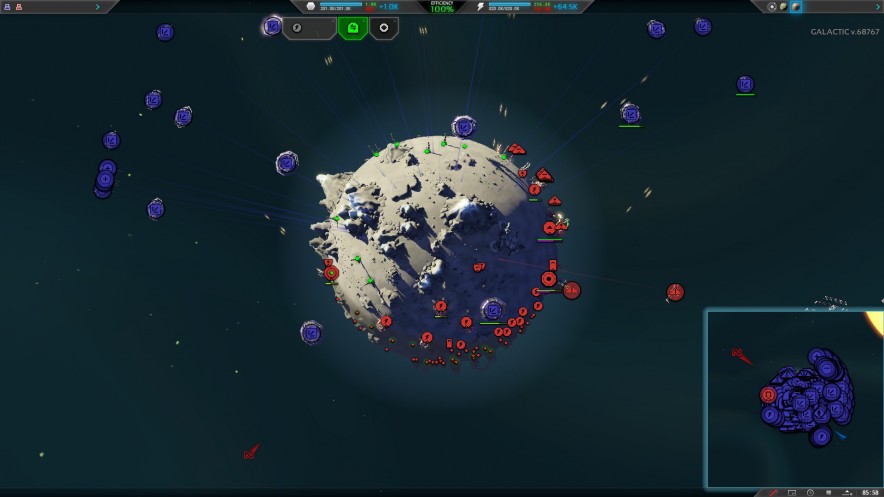First Contact: A Planetary Annihilation Review

Publisher: – Uber Entertainment/Digital Release (On Steam and Ubernet)
Developer: – Uber Entertainment
Platform: – PC (Vista 64 Bit or better), Mac (OS X 10.7 64 bit or better), Linux (Mainstream Distros, 64 bit OS)
Genre: – Real Time Strategy
Released: – 05/09/2014
Rating: – N/A
System Requirements: – A full breakdown is found here, in short, bring a powerful rig.
Online Features: – Full multiplayer suit, including finding matches, multiplayer online battles and streaming capability. Requires an Online Connection for all Gameplay (Though Devs have said that this will change in later updates).
Planetary Annihilation!
After almost two years, and nearly a year and whole new development stage later. We’ve arrived with Planetary Annihilation, a pure RTS game in the same vein as such veterans as Supreme Commander and Total Annihilation. The game has finally reached our stores, Steam, Origin and their own platform known as Ubernet.
It’s no secret I’ve been waiting for this game for a long while. So how does it hold up in the various aspects? Well then, let’s start with one of the core concepts of the game. The streaming economy.
In traditional RTS games, purchasing building and units happens upfront and the units begin construction. This is a fairly common scheme in nearly every RTS game out there, from good old-fashioned Red Alert 2 to the modern iterations of Starcraft 2. The effect it has is that you can only ever queue up units and buildings until you run out of money.
After that, you have to wait for more resources, another battle or just doing a bit of scouting. In planetary annihilation and other games like it, resources are only taken up over time in a concept known as the streaming economy. The result is that you can queue up as many units or buildings as you’d like but the limit is in how many unit production buildings you have running at the same time rather than the amount of units you can buy.
The effect of this is that economy is more about balancing out constant production vs the ability to greatly over expand unit production at the expense of the stores of metal and power, the only two resources in the game. In truth I find I prefer this model of economy rather than that of the upfront cost economy. It’s a little trickier to balance it properly, but if you do you generally find that you are almost always doing something involving the economy or expanding.
The resources have their own different balance as well, energy is plentiful in nature, easy to stockpile and generally hard to go over budget on. To counter, a lot of units require energy and some of the higher tier units can suck down excessive amounts of power to the point where one unit can require around 20,000 worth of energy units every second.
Metal is harder to find, slower to stockpile and fixed in location meaning that it’s more often than not Metal that limits any early game economy. The upside to this is that Metal also tends is fairly slow in increasing demand as you progress through the different tiers meaning that there’s often less of a demand on Metal as the game ramps up towards the end. Additionally Metal is augmented by the recycling of unit wrecks using a process known as “Reclamation” allowing your enemy wrecks to fuel your war effort.
Of course, the question that comes up next is, “How does this effect battles?”
In truth, it’s actually one of the biggest factors in deciding combat. Planetary Annihilation tends to focus more on large-scale combat than the nitty-gritty of individual units, meaning that its strategic element comes from unit composition of your army as well as balancing out unit production vs stockpiling.
Unlike its spiritual ancestor, Supreme Commander, the game has five different unit types this time around. With the additional unit type being that of the space forces, adding space control to the traditional three fields of play for RTS games of this nature. Space is often key in how you deal with the land combat, the traditional trope of playing space like naval combat is well and alive in Planetary Annihilation with space’s primary role serving that of allowing planetary invasions.
This adds an interesting new element into the mix, as it was common for me to establish a teleporter on a new planet, send my units through and establish a further beachhead in space to prevent instant kill pushback such as nuclear missile launches and counter attacking Space to Planet attacks. On the more traditional level, on the planetary level you have the standard quad of Land/Bot/Air and Naval forces at your disposal.
The main fighting tends to see you use Land and Bot forces as the main thrust in nearly any attack, as the other two unit types lack the ability to teleported across space via a teleporter. Though air units can be transported via the Astraeus planetary transporters but having only a single unit cap sees it used as a poor man’s teleporter network/ getaway vehicle for the commander more than anything else.
Asteroid Getaway
Another key feature of the game is that the commander is key to victory. Not only is it one of the strongest early game units, as well as being more or less all terrain and being able to tackle any unit type outside of space units. This is on top of having a natural bonus towards production of buildings and giving a good boost to the economy in the early game.
However one facet of the commander makes it a very weak, strategically speaking, unit. If it blows up, and if it does it’ll take out nearly any unit or building for a considerable radius, then the game is over. The commander is the final victory condition, a conceit towards the multi-planetary nature of the game giving it a large scope in terms of distance. Kill the commander, and the game is yours.
End result is that killing the commander early is viable strategy during gameplay, and is almost recommended as nearly every method of attack has a counter.
Asteroid/Planet smashing is able to be stopped mid stride by destroying the Hailey’s. Making it possible, if improbable, to stop a planet smash, more so if you happen to have a few nuclear warheads hanging around. Nuclear warheads are frequently stopped by anti-nuclear launchers. And they come in batches of three over the singular warheads of the nuclear launcher meaning that you have to build, in theory, three times as many nuclear missiles as the other guy has anti-nuclear launchers.
And before I forget, the planetary laser is equally haltable by destroying one of five priming points. It means you’ll lose at most one planet, provided you have spread over multiple planets and into other areas.
In short, the best method for killing the commander as the game progresses becomes numbers. Legions upon legions of units from both tier two and tier one production centres. Even that is difficult however as a heavily reinforced planet might require thousands of space planes to carve out enough space to build a teleporter and enough free room to ensure the safe transfer of units.
In short, you have a lot of ways of winning the game, and all are fairly valid providing you’re willing to put the work in. All of this comes accompanied with the pleasure of an orchestral soundtrack and unique sounds for your enjoyment. The sound design in particular is pretty useful, with certain events or units having distinctive sounds. The nuclear missile is a prime example of this, with it having a particularly annoying beeping sound.
The planetary laser also has much the same done for it, with the various focusing arms having their own sound to showcase the charge up and discharge of enough energy to vaporise an entire planet. The sound design is nice though admittedly the sound warnings often come too late to have much effect, especially on larger maps involving multiple planets, leaving future thought as a better guide to establishing defensive buildings.
I suppose the final question ask is, “What about the buildings?” Thankfully I’ve got an annoying voice in my ear reminding me of all these questions that must be answered. Well in the game there are three different types of buildings. Production, those buildings that focus primarily upon building something or harvesting resources, Defensive, those buildings that focus primarily on defending you from getting destroyed and finally you have Augmentive, those buildings that assist you in some fashion such as providing intelligence or transporting units between two planets.
The vast majority of your buildings are going to focus around Production. The production of resources and units in particular, looking at production buildings you see a small-scale tech tree. With every building, there’s a better tier 2 variant that offers better units, increased resources or quicker building times. Defensive buildings are probably going to be the second most populous building type in your fledgling little base. With the ability to provide physical protection in the form of unit destroying buildings like the Laser Cannon to the space unit killer the Umbrela. They also provide the ability to wall off certain areas using walls, providing safe areas for your base.
The final area of note is that of Augmentive buildings, these are usually the least frequent types of buildings produced. This is generally due to the infrequent need for them, for instance one type of radar can provide cover for an entire planet. And you only really need one deep space radar to provide coverage for the orbital plane.
In truth, the major buildings from this type you’ll be building are going to be things like Artillery units like the Pelter as well as the nuclear missiles/anti-nuclear missiles. In short you’ll be building units here primarily to help major attacks and hold off offensive strikes against yourself.
Pages: 1 2







![[PROTOTYPE]](http://www.enthusiacs.com/wp-content/uploads/2020/03/title-104x104.jpg)



Leave a Reply